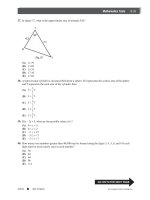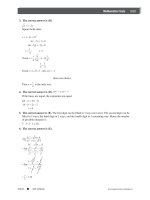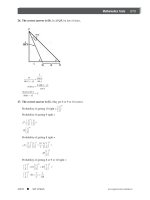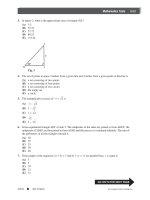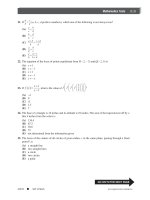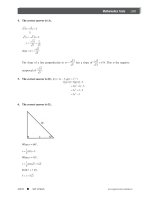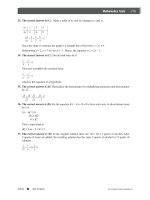SAT II Biology Episode 2 Part 7 doc
Bạn đang xem bản rút gọn của tài liệu. Xem và tải ngay bản đầy đủ của tài liệu tại đây (221.5 KB, 20 trang )
5. The hydrogen bonds in water are a result of
(A) the hydrogen of one molecule bonding
to the hydrogen of another molecule.
(B) the oxygen of one molecule bonding to
one of the hydrogens of that molecule.
(C) the hydrogen of a water molecule
bonding to the nitrogen of another.
(D) the hydrogen of one molecule bonding
to the oxygen of another molecule.
(E) none of the above.
6. Which of the following describe the
physical dimensions for DNA?
I. The nitrogen bases are 0.34 nm from
one another, moving 58 to 38.
II. The diameter of the strand is 20 nm.
III. The two strands run antiparallel.
(A) I only
(B) II only
(C) III only
(D) I and II
(E) I and III
Questions 7–8 refer to the following table.
7. Which of the following DNA sequences
would code for the polypeptide glutamine,
lysine, histidine?
(A) CAG AAA CAU
(B) ACT CCC ACG
(C) GUC UUU GUA
(D) GTC TTT GTA
(E) none of the above
8. If a DNA strand contained the sequence
ATG AGT CGT, what one base substitution
could keep the translation from being
completed?
(A) AtoG
(B) TtoA
(C) GtoC
(D) CtoG
(E) GtoA
➡
GO ON TO THE NEXT PAGE
PRACTICE TEST 3
TEST 3—Continued
297
Peterson’s n SAT II
Success: Biology E/M www.petersons.com
9. A consensus sequence is associated with
__________, while a signal sequence is part
of __________.
(A) translation, hnRNAs
(B) DNA, translation
(C) transcription, a snurp
(D) hnRNA, a snurp
(E) spliceosomes, translation
10. Plants produce energy in their
I. cytosol.
II. mitochondria.
III. chloroplasts.
(A) I only
(B) II only
(C) III only
(D) II and III
(E) I, II, and III
11. Which cell structure is represented in the
drawing above?
(A) plasma membrane
(B) chloroplast
(C) endoplasmic reticulum
(D) golgi apparatus
(E) mitochondrion
12. One would expect to find steroid hormone
receptors in the
(A) plasma membrane.
(B) endoplasmic reticulum.
(C) nucleus.
(D) cytosol.
(E) none of the above.
PRACTICE TEST 3
TEST 3—Continued
298
Peterson’s n SAT II
Success: Biology E/Mwww.petersons.com
Questions 13–14 refer to the following
diagram.
13. All the arrows are associated with the
process of
(A) carbon fixation.
(B) photochemical reactions.
(C) anaerobic respiration.
(D) aerobic respiration.
(E) oxygen fixation.
14. Letter X most likely represents
(A) the stroma.
(B) the matrix.
(C) the thylakoid space.
(D) the grana.
(E) none of the above.
15. The enzyme that assimilates carbon dioxide
into the Calvin cycle is known as
(A) rubisco.
(B) pepco.
(C) catalase.
(D) PEP carboxylase.
(E) malate hydrogenase.
16. Which element acts as a hydrogen acceptor
during aerobic respiration?
(A) hydrogen
(B) carbon
(C) oxygen
(D) nitrogen
(E) phosphorus
Questions 17–19 refer to the following
infor mation.
17. Which molecule is the primary energy
source for animals?
(A) A
(B) B
(C) C
(D) D
(E) E
➡
GO ON TO THE NEXT PAGE
PRACTICE TEST 3
TEST 3—Continued
299
Peterson’s n SAT II
Success: Biology E/M www.petersons.com
18. Which molecule is an amino acid?
(A) A
(B) B
(C) C
(D) D
(E) E
19. What molecule is a product of the Kreb’s
cycle?
(A) B
(B) C
(C) D
(D) E
(E) F
20. The separation of plant pigments using
paper chromatography is based on
(A) the non-polarity of the solvents and
pigments.
(B) the polarity of the paper.
(C) the polarity of the pigments.
(D) all of the above.
(E) none of the above.
21. The enzyme that charges tRNA molecules
has as it substrate(s)
I. an amino acid.
II. ATP.
III. tRNA.
IV. snRNA.
(A) I only
(B) II only
(C) III only
(D) I, II, and III
(E) I, II, III, and IV
Questions 22–23 refer to the following
diagram.
PRACTICE TEST 3
TEST 3—Continued
300
Peterson’s n SAT II
Success: Biology E/Mwww.petersons.com
22. The diagram above illustrates __________
and shows that most energy is lost as
_________.
(A) the first law of thermodynamics, fast as
it arrives
(B) the second law of thermodynamics,
heat
(C) the second law of thermodynamics, fast
as it arrives
(D) the first law of thermodynamics,
decomposition
(E) the second law of thermodynamics,
decomposition
23. The amount of energy bound up in the
second consumer’s level is approximately
__________ of the radiant energy falling on
the system.
(A) 5 percent
(B) 0.5 percent
(C) 0.1 percent
(D) 0.01 percent
(E) 0.05 percent
24. Organisms are placed in different trophic
levels according to how they obtain their
energy. Another name for primary con-
sumer is
(A) green plant.
(B) herbivore.
(C) carnivore.
(D) omnivore.
(E) decomposer.
Questions 25–26 refer to the drawing
below.
25. Which letter represents the process of
transpiration?
(A) A
(B) B
(C) C
(D) D
(E) none of the above
26. Over time, according to the theories of
succession,
(A) the lake will get deeper and the trees
more numerous.
(B) the lake will get shallower and the trees
will be replaced by grass.
(C) the lake will dry up.
(D) the trees will become coniferous types.
(E) there is no fixed order to the replace-
ment of species.
➡
GO ON TO THE NEXT PAGE
PRACTICE TEST 3
TEST 3—Continued
301
Peterson’s n SAT II
Success: Biology E/M www.petersons.com
27. Some organisms living in a vacant lot
include grass, dandelions, mice, grasshop-
pers, and slugs. Collectively these organisms
represent
(A) an ecosystem.
(B) a community.
(C) a population.
(D) a mutualism.
(E) a biome.
28. Darwin’s finches are a group of about
twelve species of birds that live on the
Galapagos Islands. The fact that they have
different size beaks is regarded as a conse-
quence of
(A) genetic drift.
(B) coevolution.
(C) competition.
(D) chance.
(E) behavioral modification.
29. Predators in an ecosystem
(A) help the community by keeping the
number of prey from outstripping their
resources.
(B) help the prey population by removing
the sick and less fit individuals.
(C) enhance species diversity.
(D) reduce the possibility of competitive
exclusion.
(E) all of the above.
30. A walking stick, a type of insect that is a
primary consumer, is an example of an
organism using
(A) aggressive mimicry.
(B) Batesian mimicry.
(C) camouflage.
(D) Mullerian mimicry.
(E) none of the above.
31. The buildup of pesticides in ospreys is
known as
(A) biological magnification.
(B) food web dynamics.
(C) succession.
(D) keystone predation.
(E) none of the above.
32. An organism with the genotype AaVv can
produce how many different types of
gametes?
(A) 1
(B) 2
(C) 4
(D) 6
(E) 8
PRACTICE TEST 3
TEST 3—Continued
302
Peterson’s n SAT II
Success: Biology E/Mwww.petersons.com
Questions 33–34 refer to the following
diagram.
33. A cell has four chromosomes, which are
represented in the original cell drawing. At
the end of meiosis I, which of the other
four drawings represents a possible out-
come?
(A) I only
(B) II only
(C) III only
(D) IV only
(E) none of the above
34. At the end of meiosis II, which of the
drawings represent(s) possible outcomes?
(A) I only
(B) II only
(C) II and III
(D) III and IV
(E) IV only
35. In minks, the gene for brown fur (B) is
dominant to the gene for silver fur (b).
Which set of genotypes represents a cross
that could produce offspring with silver fur
from parents that both have brown fur?
(A) Bb × Bb
(B) BB × Bb
(C) BB × bb
(D) Bb × bb
(E) none of the above
36. In four-o-clocks, pink flowers are the result
of a red allele and a white allele for the
color gene. If you crossed a white with a
pink, what would be the most likely result?
(A) 20 red and 20 pink
(B) 40 pink
(C) 20 pink and 20 white
(D) 20 red and 20 white
(E) 40 white
➡
GO ON TO THE NEXT PAGE
PRACTICE TEST 3
TEST 3—Continued
303
Peterson’s n SAT II
Success: Biology E/M www.petersons.com
37. In four-o-clocks, in addition to the flower
color above, some plants may be tall
(dominant) while others are short (reces-
sive), based on a gene that is not on the
same chromosome as the gene for flower
color. A pure bred tall, red four-o-clock was
bred to a pure bred white, short four-o-
clock. Then the resulting F1 was crossed to
get the F2. Approximately how many of the
F2 will be short and pink?
(A)
1
⁄
16
(B)
2
⁄
16
(C)
3
⁄
16
(D)
4
⁄
16
(E)
6
⁄
16
38. A colorblind man married a woman who
wasn’t colorblind, but her father had been.
What is the possibility that their first child
will be a colorblind girl?
(A) 0 percent
(B) 25 percent
(C) 50 percent
(D) 75 percent
(E) 100 percent
39. A man with type O positive blood married a
woman with type B negative blood. What is
(are) the types of blood that their children
can have?
(A) B positive
(B) O positive
(C) B negative and B positive
(D) O negative and O positive
(E) B negative and positive and O negative
and positive
40. People who have an extra X chromosome
could have gotten it through
(A) nondisjunction.
(B) transposition.
(C) transduction.
(D) crossing over.
(E) all of the above.
41. The HIV virus infects mostly
(A) complement cells.
(B) red blood cells.
(C) T-killer cells.
(D) T-helper cells.
(E) all of the above.
42. Select the correct order of events in a
person’s response to a bacterial infection:
(A) macrophage ingestion → Helper T cell
activation → B cell activation → clonal
formation
(B) clonal formation → Helper T cell
activation → B cell activation →
macrophage ingestion
(C) macrophage ingestion → B cell
activation → T helper cell activation →
clonal formation
(D) Helper T cell activation → B cell
activation → macrophage ingestion →
clonal formation
(E) B cell activation → T helper cell
activation → clonal formation →
macrophage ingestion
PRACTICE TEST 3
TEST 3—Continued
304
Peterson’s n SAT II
Success: Biology E/Mwww.petersons.com
43. Blood entering the dorsal aorta has most
recently been in the
(A) right atria.
(B) right ventricle.
(C) left atria.
(D) left ventricle.
(E) pulmonary vein.
44. Carbon dioxide that is leaving the body is
carried in
I. the plasma.
II. erythrocytes.
III. hemoglobin molecules.
(A) I only
(B) II only
(C) III only
(D) I and II
(E) I, II, and III
45. Carbohydrate digestion begins in the
__________ with the action of the enzyme
__________.
(A) mouth, amylase
(B) stomach, pepsin
(C) stomach, chymotrypsin
(D) small intestine, amylase
(E) small intestine, cholecystokinin (CCK)
46. The function of ATP in voluntary muscle
movement is to supply the energy for
(A) myosin to bind to actin.
(B) myosin to become separated from
actin.
(C) tropomyosin to bind to troponin.
(D) tropomyosin to become separated from
troponin.
(E) tropomyosin to become separated from
actin.
➡
GO ON TO THE NEXT PAGE
PRACTICE TEST 3
TEST 3—Continued
305
Peterson’s n SAT II
Success: Biology E/M www.petersons.com
Question 47 refers to the above drawing.
47. Choose the one correct statement from the
following.
(A) A = muscle; B = tendon; C = ligament;
D = ulna
(B) A = ligament; B = muscle; C = radius; D
= tendon
(C) A = ligament; B = muscle; C = tendon;
D = radius
(D) A = tendon; B = muscle; C = ligament;
D = radius
(E) A = tendon; B = muscle; C = ligament;
D = ulna
48. Curare acts on the same receptors as
acetylcholine but does not cause the effect
of acetylcholine, nor is it easily decomposed
or cleaved by cholinesterases. Injection of
curare into a person could result in
I. epileptic seizures.
II. muscle relaxation.
III. suffocation.
(A) I only
(B) II only
(C) III only
(D) I and II
(E) II and III
49. The undershoot during an action potential
is the result of
(A) the sodium gates being closed and the
potassium gate open.
(B) the sodium gates being closed and the
potassium gate closed.
(C) the sodium gates being open and the
potassium gate closed.
(D) the sodium gates being open and the
potassium gate open.
(E) one of the sodium gates being open,
one closed, and the potassium gate
open.
50. In the development of a frog embryo,
Speman’s primary organizer was found to
be the
(A) dorsal ectoderm.
(B) dorsal lip of the blastopore.
(C) archenteron.
(D) neural tube.
(E) notochord.
PRACTICE TEST 3
TEST 3—Continued
306
Peterson’s n SAT II
Success: Biology E/Mwww.petersons.com
51. Choose the one statement that is true from
among the following.
(A) FSH is produced in the ovaries and
causes maturation of the follicle.
(B) LH is produced in the pituitary gland
and causes ovulation.
(C) Estrogen is produced in the anterior
pituitary gland and causes the en-
dometrium to thicken.
(D) Progesterone is produced in the
posterior pituitary gland and causes the
endometrium to thicken.
(E) None of the above statements are true.
52. If 9 percent of all cicadas exhibit the
homozygous recessive condition known as
“flippant wings,” what is the gene fre-
quency for that gene in the general popula-
tion?
(A) cannot be determined
(B) 91 percent
(C) 0.9
(D) 0.3
(E) 0.03
53. The wings of a bird and those of an insect
are a good example of
(A) adaptive radiation.
(B) coevolution.
(C) convergent evolution.
(D) all of the above.
(E) none of the above.
54. Which one of the following lists contains an
organism that does NOT belong in that
phylum?
(A) jellyfish, coral, anemone, starfish
(B) tunicates, birds, sharks, man
(C) bats, dogs, cats, sloths
(D) liver fluke, planaria, tapeworm,
flatworms
(E) clam, squid, nautilus, snail
55. Choose the most Darwinian reason to
describe how camels came to have flat,
broad hooves.
(A) The camels that ventured further into
the desert acquired broader feet, which
were passed along to their offspring.
(B) Those animals that had the broadest
hooves were the most attractive to the
opposite sex.
(C) The animals that had the broadest
hooves were able to travel farther and
find water more easily than those that
couldn’t and subsequently perished.
(D) Those animals with the broadest feet
are descended from the camels that got
broad feet from stomping out the forest
fires that created the desert in the first
place.
(E) In the game of life, random events will
move evolution toward the most
successful adaptations possible.
➡
GO ON TO THE NEXT PAGE
PRACTICE TEST 3
TEST 3—Continued
307
Peterson’s n SAT II
Success: Biology E/M www.petersons.com
56. The age of the Earth is about __________
years, and life has existed on the Earth for
__________ years.
(A) 3.5 billion, 2.5 billion
(B) 3.5 billion, 1.5 billion
(C) 15 billion, 3.5 billion
(D) 4.5 billion, 600 million
(E) 4.5 billion, 3.5 billion
57. Which of the following could be used to
study evolution?
(A) DNA hybridization
(B) RFLPs
(C) structural homologies
(D) fossils
(E) all of the above
58. Which of the following is (are) a domain(s)?
I. Eukaryota
II. Archaebacteria
III. Eubacteria
(A) I only
(B) II only
(C) III only
(D) I and III
(E) I, II, and III
59. Which of the following organisms lacks a
coelom?
(A) roundworms
(B) segmented worms
(C) clams
(D) grasshoppers
(E) people
60. Donald Johanson, Tom Gray, and others
discovered a hominid that lived in East
Africa__________ million years ago and
nicknamed her Lucy, whose scientific name
they gave as __________.
(A) 35, Homo habilis
(B) 3.5, Homo africanus
(C) 5.5, Australopithecus africanus
(D) 3.0, Australopithecus afarensis
(E) 5.5, Australopithecus boisei
STOP
IF YOU ARE TAKING THE BIOLOGY-E TEST, CONTINUE WITH QUESTIONS 61–80.
IF YOU ARE TAKING THE BIOLOGY-M TEST, GO TO QUESTION 81 NOW.
PRACTICE TEST 3
TEST 3—Continued
308
Peterson’s n SAT II
Success: Biology E/Mwww.petersons.com
BIOLOGY-E TEST
Directions: Each of the questions or statements below is accompanied by five choices. For each
question, select the best of the answer choices given.
61. Ammonia is released from dead plants by
(A) denitrifying bacteria.
(B) nitrogen-fixing bacteria.
(C) bacteria of decay.
(D) nitrifying bacteria.
(E) none of the above.
Questions 62–65 refer to the following
infor mation.
62. Which statement correctly describes a
relationship between the species of
columns 1 and 2?
(A) The species in column 1 help to
determine which species are in column
2.
(B) The species in column 2 help to
determine which species are in column
1.
(C) The species in column 1 are dependent
on the species in column 2.
(D) The species in both columns 1 and 2
help to determine the climate of the
area.
(E) None of the above is true.
63. Letter A most likely represents
(A) a biosphere.
(B) a biome.
(C) a bathysphere.
(D) an ecosystem.
(E) a community.
64. Letter B most likely represents
(A) black bears.
(B) beavers.
(C) sugar maples.
(D) conifers.
(E) foxes.
65. Letter C most likely represents
(A) squirrels and deer.
(B) antelope and bison.
(C) monkeys and leopards.
(D) caribou and snowy owls.
(E) fungi and algae.
➡
GO ON TO THE NEXT PAGE
PRACTICE TEST 3
TEST 3—Continued
309
Peterson’s n SAT II
Success: Biology E/M www.petersons.com
Questions 66–68 refer to the following
infor mation.
An investigator went to Central America to
study oropendulas, which are communal nesting
birds. Another species of bird, the cowbird,
sometimes lay its eggs in the nests of oropen-
dulas. Some of the populations of oropendulas
throw the cowbird eggs out of the nest, and
some don’t. The investigator was interested in
finding out why some birds would raise other
species as their own but others would toss them
out. By watching the nests closely, he found
that blowflies lay their eggs in the nests of
oropendulas, and that the young larvae, mag-
gots, feed on the young birds. If young cowbirds
are in the nest, the precocious cowbirds eat the
blowfly larvae, protecting the young oropen-
dulas. In colonies of oropendulas that discrimi-
nate against cowbirds, throwing them from the
nest, the blowflies are not eaten by cowbirds.
These colonies of oropendulas build their nests
close to a particular wasp colony, and the wasps
eat the blowflies.
66. The relationship between the oropendulas
that don’t discriminate against cowbirds and
the cowbirds is one of
(A) commensalism.
(B) predation.
(C) mutualism.
(D) competition.
(E) annilism.
67. The relationship between the blowfly and
the cowbirds that are associated with the
non-discriminating oropendulas is one of
(A) commensalism.
(B) predation.
(C) mutualism.
(D) competition.
(E) annilism.
68. The relationship between the oropendulas
that discriminate against cowbirds and the
cowbirds is one of
(A) commensalism.
(B) predation.
(C) mutualism.
(D) competition.
(E) annilism.
PRACTICE TEST 3
TEST 3—Continued
310
Peterson’s n SAT II
Success: Biology E/Mwww.petersons.com
Questions 69–70 refer to the above drawing.
69. Which statement best describes one of the
levels of this pyramid?
(A) Level A contains the largest producers
in the pyramid.
(B) The organisms in level B obtain food
directly from level A.
(C) Level C contains the largest group of
consumers in the pyramid.
(D) Level D contains the greatest number of
heterotrophs in the pyramid.
(E) Levels C and D both contain producers.
70. Which of these levels would be most
susceptible to biological magnification?
(A) A
(B) B
(C) C
(D) D
(E) They would all be equally affected.
71. In a natural community, all the living things
that directly or indirectly affect the environ-
ment are known as
(A) pioneer organisms.
(B) keystone species.
(C) secondary consumers.
(D) climatic factors.
(E) biotic factors.
72. In order to preserve the biosphere for
future generations, humans must
(A) make use of technology to develop new
herbicides.
(B) put all wild animals in game preserves.
(C) explore ways to drain and fill wetlands
along the seacoast.
(D) understand how living things interact
with their environment.
(E) settle more people inland, away from
the coasts.
➡
GO ON TO THE NEXT PAGE
PRACTICE TEST 3
TEST 3—Continued
311
Peterson’s n SAT II
Success: Biology E/M www.petersons.com
73. Which group can best be described as a
population?
(A) all the honeybees in an orchard in one
spring
(B) all the plants and animals in a forest
(C) the living and nonliving factors in a
meadow
(D) the life in Earth’s atmosphere
(E) all the buffalo in 1840
Questions 74–75 refer to the following
graph.
74. Assume first that the graph above shows
the changes in two populations of herbi-
vores in a grassy field. A possible reason for
these changes is that
(A) all of the plant populations in this
habitat decreased.
(B) population B competed more success-
fully for food than did population A.
(C) population A produced more offspring
than population B did.
(D) population A consumed the members
of population B.
(E) over time, both populations will have
the same average number.
75. Assume now that the graph above shows
the changes in any two populations in a
grassy field. Choose which of the following
statements are true.
I. A could represent predators and B prey.
II. A could represent prey and B predators.
III. A could be a host infested by the
pathogen B.
(A) I only
(B) II only
(C) III only
(D) I and II
(E) II and III
76. Competition between the members of a
woodchuck population in a large field could
be expected to increase as a result of an
increase in the
(A) woodchuck reproduction rate.
(B) spread of disease among the wood-
chucks.
(C) number of woodchucks killed by cars.
(D) number of secondary consumers.
(E) natality rate of their predators.
77. Let r stand for the intrinsic rate of growth,
N for the number of organisms in a popula-
tion, and K for the carrying capacity. A
good formula for logistic growth would be
(A) rN (N–K)/K
(B) rN (N–r)/rK
(C) rK (K–N)/rN
(D) rK (r–N)/K
(E) rN (K–N)/K
PRACTICE TEST 3
TEST 3—Continued
312
Peterson’s n SAT II
Success: Biology E/Mwww.petersons.com
78. Mimicry is an important biotic factor in
communities all over the world. For
instance, viceroy butterflies closely re-
semble (mimic) monarch butterflies. Birds
that eat viceroys enjoy a good meal, but
those that eat monarchs retch right away.
What type of mimicry does this describe?
(A) Mullerian
(B) aggressive
(C) crypsis
(D) Batesian
(E) deflection
79. Probably the world’s most pressing ecologi-
cal problem is
(A) destruction of the rain forests.
(B) global warming.
(C) depletion of natural resources.
(D) over-fishing the oceans.
(E) human overpopulation.
80. Predators are beneficial to communities
because
(A) they control the prey population
growth.
(B) they practice predation harvest.
(C) predators enhance species diversity.
(D) Both (A) and (B).
(E) (A), (B), and (C).
STOP
If you answered the first 80 questions STOP HERE.
If you are taking the Biology-M test CONTINUE HERE.
PRACTICE TEST 3
TEST 3—Continued
313
Peterson’s n SAT II
Success: Biology E/M www.petersons.com
BIOLOGY-M TEST
Directions: Each of the questions or statements below is accompanied by five choices. For each
question, select the best of the answer choices given.
Questions 81–82 refer to the following
table.
Messenger RNA (mRNA) Codes for
Selected Amino Acids
Amino Acid mRNA Code
Leucine C–C–A
Arginine C–G–A
Phenylalanine U–U–U
Valine G–U–U
Lysine A–A–A
81. What would be the DNA triplet that would
code for the addition of arginine to a
polypeptide?
(A) C–G–A
(B) G–C–T
(C) C–C–T
(D) T–A–C
(E) G–C–U
82. Which amino acid would be attached to a
polypeptide chain if the amino acid was
attached to the anticodon A–A–A?
(A) phenylalanine
(B) lysine
(C) valine
(D) a stop codon
(E) cannot be determined from the
information given
83. Which of the following functions can be
attributed to DNA polymerase?
(A) It replaces RNA nucleotides with DNA
nucleotides.
(B) It fixes errors in the replication of
DNA.
(C) It ads nucleotides to the growing chain
at the 3' end.
(D) It is used in the polymerase chain
reaction.
(E) All of the above are true.
84. During translation, the first amino acid
(A) occupies the aminyl site first, then the
peptidyl site.
(B) occupies the aminyl site before the
attachment of the large portion of the
ribosome.
(C) of the polypeptide chain is methionine.
(D) all of the above
(E) none of the above
PRACTICE TEST 3
TEST 3—Continued
314
Peterson’s n SAT II
Success: Biology E/Mwww.petersons.com
85. A signal sequence
(A) is a sequence of DNA that begins
transcription.
(B) is a sequence of RNA that is spliced out
in the nucleus.
(C) is a sequence of DNA that directs a
protein to certain organelles.
(D) is a sequence of DNA that attracts
transcription factors.
(E) is the sequence of tRNA that bonds
with the codon of mRNA at the
ribosome.
86. Which of the following substances would
NOT be present in a typical procedure for
separating proteins by gel electrophoresis?
(A) water
(B) bromophenol blue
(C) Tris buffer
(D) agarose
(E) polyacrylamide
87. Northern blotting is used with
(A) DNA.
(B) RNA.
(C) hnRNA.
(D) ssDNA.
(E) all of the above.
88. You are trying to measure mRNA synthesis
with animal cells growing in a tissue
culture. Which radioactive nucleotide
should you provide to the cells to measure
RNA synthesis?
(A) adenine
(B) cytosine
(C) guanine
(D) thymine
(E) uracil
89. Splicing of hnRNA is done in the nucleus by
“snurps.” Of what are these “snurps”
composed?
(A) RNA
(B) DNA
(C) proteins
(D) RNA and proteins
(E) DNA and proteins
90. Peter Mitchell was able to demonstrate
chemiosmosis by getting ______________ to
go down their concentration gradient by
using two different ___________.
(A) potassium ions, light frequencies
(B) hydrogen ions, light frequencies
(C) potassium ions, pH solutions
(D) hydrogen ions, pH solutions
(E) potassium ions, electromagnetic
frequencies
➡
GO ON TO THE NEXT PAGE
PRACTICE TEST 3
TEST 3—Continued
315
Peterson’s n SAT II
Success: Biology E/M www.petersons.com
91. One would expect to find reverse tran-
scriptase in
(A) the plasmids of competent cells.
(B) retrovisuses.
(C) purple sulfur bacteria.
(D) plasmodia.
(E) archaebacteria.
92. The target tissue for parathyroid hormone is
(are) the
(A) kidneys.
(B) bones.
(C) small intestine.
(D) all of the above.
(E) none of the above.
93. The products of oxidative phosphorylation
are
(A) oxygen and water.
(B) NADH and ATP.
(C) pyruvate and NADPH.
(D) water and ATP.
(E) oxygen and NADH.
94. A major difference between gram positive
and gram negative bacteria is that the
former has
(A) a liposaccharide outer covering with a
small peptidoglycan component in the
cell wall.
(B) a small peptidoglycan component
covering a large liposaccharide base.
(C) a large peptidoglycan component in the
cell wall.
(D) a cell wall composed of liposaccharide
and chitin.
(E) a cell wall composed of chitin over
peptidoglycan.
95. Let X represent an atom and X* its radioac-
tive isotope. Assume both are taken up by
living organisms. If the half-life of X* is
4,000 years, how much X* will be present
in the remains of an organism that is 16,000
years old?
(A) as much as a living organism
(B) 4 times as much
(C)
1
⁄
4
as much
(D)
1
⁄
16
(E) indeterminate given the lack of climatic
data
PRACTICE TEST 3
TEST 3—Continued
316
Peterson’s n SAT II
Success: Biology E/Mwww.petersons.com


